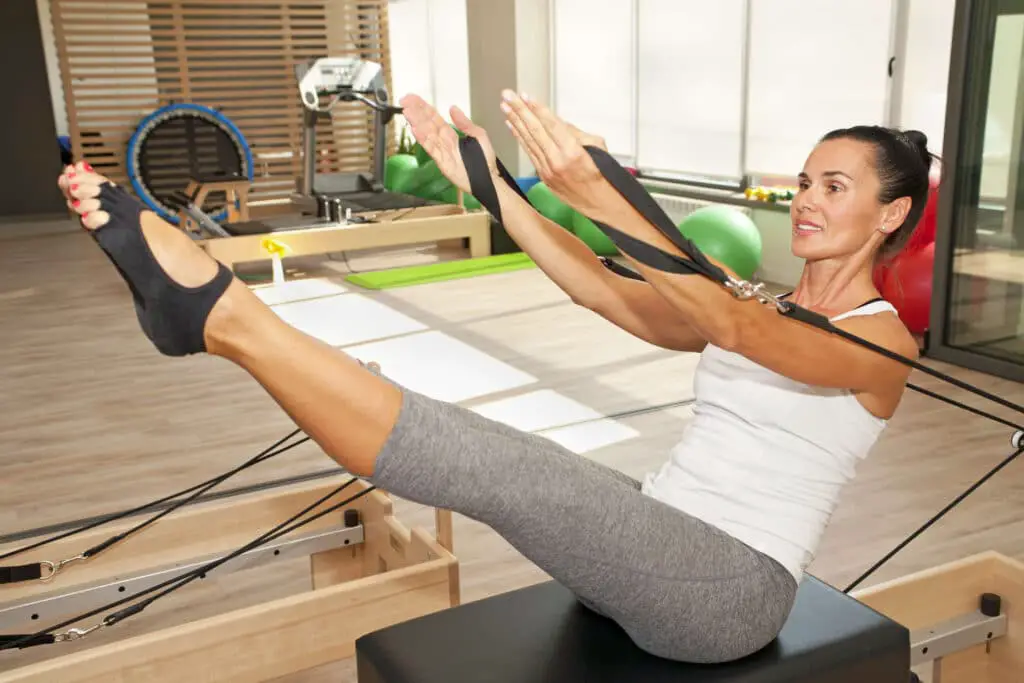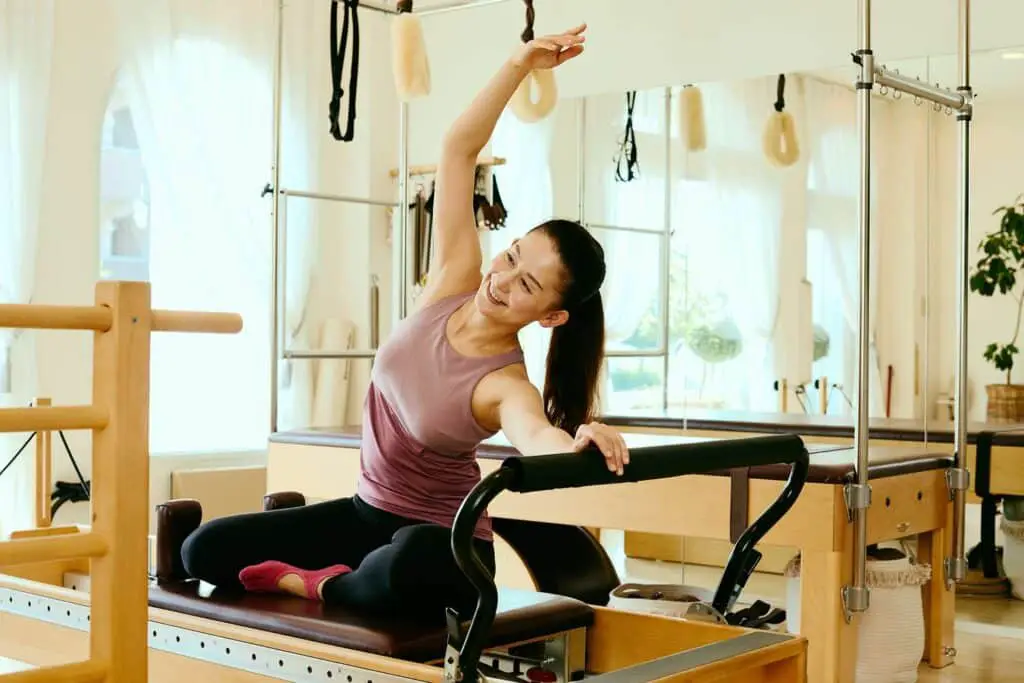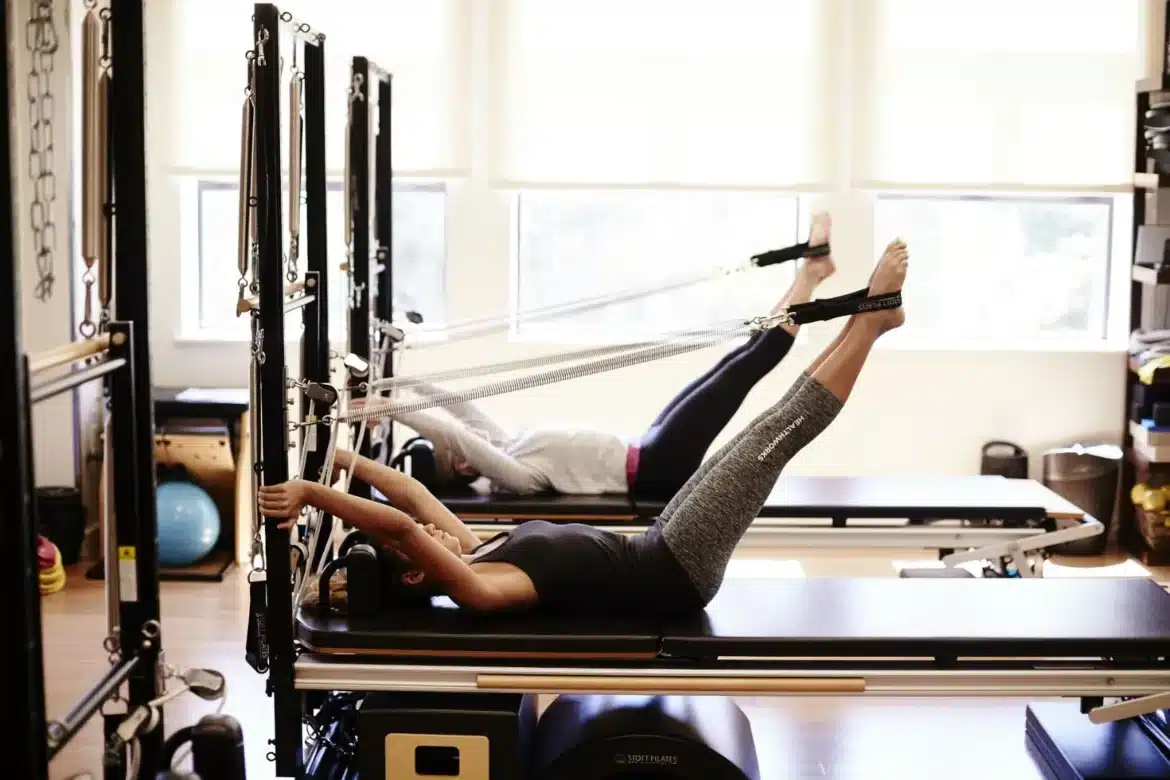Introduction
How To Use Pilates Machine: Pilates is a highly effective exercise method that focuses on strengthening the body’s core, improving flexibility, and enhancing overall body awareness. While many Pilates exercises can be performed on a mat, using a Pilates machine, often referred to as a Pilates reformer or Cadillac, can take your Pilates practice to the next level. These machines provide added resistance and support, allowing for a more dynamic and versatile workout experience.
In this guide, we will explore the basics of using Pilates machines, including essential techniques, safety considerations, and the numerous benefits they offer. Whether you’re a seasoned Pilates practitioner or a beginner looking to incorporate Pilates into your fitness routine, understanding how to use Pilates machines effectively can help you achieve your fitness goals and promote better overall health and well-being. So, let’s dive in and discover the transformative world of Pilates machine exercises.
Like any fitness regimen, consistency is key to experiencing the benefits of Pilates machine exercises. Results may not be immediate, but with dedication and patience, you’ll notice improved strength, flexibility, and overall body awareness. In this guide, we will delve deeper into the specifics of using various Pilates machines, outlining fundamental exercises and providing tips to help you maximize your Pilates machine workouts. Whether your goal is to enhance core strength, alleviate back pain, or achieve better overall fitness, Pilates machines can be a valuable tool in your journey to a healthier and more balanced body.

Does Pilates machine work?
A Pilates reformer can be an efficient workout tool to strengthen and lengthen muscles. As with other exercise equipment and new workouts, always remember to start and increase difficulty slowly and under the guidance of a professional in order to prevent injury.
Do Pilates Machines Work
Enhanced Resistance: One of the key advantages of Pilates machines is the adjustable resistance they provide. This feature allows users to progressively challenge their muscles, making it effective for building strength over time. The reformer, for example, can be used to perform a wide range of exercises that work various muscle groups, leading to noticeable improvements in strength and muscle tone.
Improved Flexibility: Pilates machines facilitate movements that promote flexibility by stretching and lengthening the muscles. The gentle, controlled stretching on these machines can help increase joint mobility and reduce the risk of injury. This can be particularly beneficial for individuals looking to improve their flexibility, whether they are beginners or experienced practitioners.
Core Strengthening: Pilates is renowned for its focus on core strength, and Pilates machines are no exception. Many exercises on these machines target the abdominal muscles, obliques, and lower back, helping individuals develop a strong and stable core. A strong core can improve posture, alleviate back pain, and enhance overall body balance.
Body Awareness: Pilates emphasizes precise movements and body awareness, and the feedback provided by Pilates machines can be invaluable in this regard. Users can fine-tune their form and alignment, ensuring that they engage the right muscles and avoid unnecessary strain. This attention to detail can lead to improved posture and body mechanics.
What is a Pilates machine good for?
Reformer Pilates can help improve and maintain overall physical fitness – leading to greater strength, flexibility and balance, which in turn improve posture, movement and mental health.
Improved Flexibility
Pilates is renowned for its emphasis on flexibility, and Pilates machines play a crucial role in achieving this goal. The controlled movements performed on these machines elongate and stretch the muscles, promoting increased flexibility and joint mobility. Over time, regular use of Pilates machines can lead to greater suppleness and reduced risk of injury.
Enhanced Posture
Many people struggle with poor posture due to sedentary lifestyles or muscle imbalances. Pilates machines promote proper alignment and body awareness, which can significantly improve posture. Strengthening the core muscles and stretching the spine through Pilates exercises can help individuals maintain an upright posture and alleviate discomfort caused by slouching or misalignment.
Injury Rehabilitation
Pilates machines are widely used in physical therapy and injury rehabilitation settings. Their low-impact nature makes them suitable for individuals recovering from injuries or surgeries. Pilates equipment can aid in the rehabilitation process by improving muscle strength, flexibility, and range of motion. It also helps patients regain confidence in their bodies after an injury.
Increased Body Awareness
Pilates places a strong emphasis on mindful movement and body awareness. The feedback provided by Pilates machines, such as the reformer or cadillac, encourages users to pay close attention to their form and alignment. This heightened awareness translates to improved movement patterns and biomechanics in daily life, reducing the risk of strain or injury.
How many minutes of Pilates is effective?
For most individuals, sticking to 20 minutes for a Pilates session is enough. So, 20 minutes / 3 times a week is a good schedule to begin with. You may find that as you get more comfortable with the routines and you begin to get stronger and more flexibile that you will want to increase this to 30 minutes or more.
Fitness Goals
The number of minutes you should dedicate to Pilates depends on your fitness goals. If you’re looking to maintain general fitness, improve flexibility, or alleviate stress, shorter Pilates sessions of 20 to 30 minutes a few times a week can be beneficial. However, if your goal is to build strength, increase muscle definition, or enhance core stability, longer sessions of 45 minutes to an hour may be more effective.
Experience Level
Your experience with Pilates matters when determining the duration of your practice. Beginners may find it challenging to maintain proper form and endurance for extended periods. It’s advisable for novices to start with shorter sessions and gradually increase the duration as they become more comfortable and confident with the exercises.
Intensity
The intensity of your Pilates practice can significantly impact the recommended duration. High-intensity Pilates workouts, which incorporate advanced exercises and more resistance, may be shorter in duration, typically ranging from 20 to 45 minutes. Lower-intensity or restorative Pilates sessions, which emphasize stretching and relaxation, can be longer, spanning 60 minutes or more.
Consistency
Consistency plays a crucial role in the effectiveness of your Pilates practice. It’s often better to engage in shorter sessions regularly than to have sporadic longer sessions. Aim for consistency in your practice schedule, whether it’s three 20-minute sessions a week or one 60-minute session.
Is 3 days of Pilates enough?
But while you will see benefits from doing Pilates once or twice weekly, exercise experts agree that the ideal is three times a week. That’s the “sweet spot,” said Ms. Samper.
Consistency
Consistency is key when it comes to Pilates or any exercise regimen. Three days of Pilates per week, done consistently, can yield positive results over time. It’s important to establish a routine that you can maintain in the long term, as sporadic workouts are less effective in achieving lasting benefits.
Individual Factors
Everyone’s body responds differently to exercise. Some individuals may see significant improvements with three days of Pilates, while others may require more frequent practice. Factors such as age, fitness level, and genetics can influence your progress and the number of days needed to achieve your goals.
Complementary Activities
Pilates can be part of a well-rounded fitness program. If you’re concerned about whether three days of Pilates is enough, consider complementing your Pilates practice with other forms of exercise. Incorporating activities like cardiovascular workouts, strength training, or yoga on non-Pilates days can help you achieve a more comprehensive fitness routine.
Is Pilates OK to do everyday?
Joseph Pilates recommended that Pilates exercises be performed every day. And the great thing about Pilates as an exercise modality is that you can perform it every day and still rest certain areas of the body (if desired).
Benefits of Daily Pilates
Consistent Progress: Daily Pilates can lead to more rapid progress in terms of strength, flexibility, and body awareness. The frequent repetition of movements allows you to reinforce good habits and maintain muscle memory.
Enhanced Core Stability: Pilates places a strong emphasis on core strengthening, and daily practice can help build and maintain a stable core, which contributes to better posture and reduced risk of back pain.
Improved Flexibility: Daily Pilates can significantly enhance flexibility by promoting regular stretching and lengthening of muscles, leading to improved joint mobility.
Stress Reduction: Pilates promotes mindfulness and relaxation through controlled movements and focused breathing, making it an effective tool for daily stress management.
Better Body Awareness: Daily practice reinforces body awareness and mindful movement patterns, which can translate into improved posture and biomechanics in everyday activities.
Can I do 20 minutes of Pilates everyday?
Commit to a 20-minute Pilates practice regularly, and you’ll see improvements in your overall fitness and focus. And yes, Pilates, unlike weight lifting or some other exercises, is safe to do every day!
Benefits of a 20-Minute Daily Pilates Practice
Consistency: Daily Pilates, even for a short duration, allows you to maintain consistency in your fitness routine. Consistency is key for building and maintaining strength, flexibility, and overall body conditioning.
Time Efficiency: In our busy lives, 20 minutes is a manageable time commitment. It’s easier to incorporate a short daily Pilates session into your schedule compared to longer workouts, making it a sustainable habit.
Improved Core Strength: Pilates places a strong emphasis on core engagement, and a daily practice can help you develop and maintain a stable core, which contributes to better posture and reduced back pain.
Enhanced Flexibility: Regular, brief Pilates sessions promote increased flexibility by consistently stretching and lengthening muscles, improving joint mobility over time.
Stress Reduction: Pilates encourages mindfulness through controlled movements and focused breathing, making it a valuable tool for daily stress management and relaxation.
Does Pilates tone you quickly?
Whilst Pilates theoretically is not the quickest route to increasing muscle mass, anecdotally many people do feel that they look more ‘toned’ when they do Pilates.
Early Changes: Many individuals experience improved posture, enhanced core strength, and a sense of increased muscle engagement within a few weeks of regular Pilates practice.
Visible Results: Visible changes in muscle tone and body composition may start to become noticeable within a few months, especially if you combine Pilates with a healthy diet and other complementary exercises.
Long-Term Progress: To achieve a well-toned body that is sustainable, it’s essential to think of Pilates as a long-term practice. Over time, with consistent effort, you can achieve a toned physique that aligns with your fitness goals.
Holistic Benefits: While toning is a common goal of Pilates, it’s important to remember that Pilates offers numerous holistic benefits beyond physical changes, including improved flexibility, reduced stress, enhanced body awareness, and better overall well-being.
Will Pilates slim my waist?
For example, Pilates exercises that have sit-ups, boards or adaptations with movements of the lower and upper limbs are the best for reducing the waist, as they require great physical effort and breakdown the fat molecules. There is no doubt: the Reformer Pilates can contribute to reducing the waist.
Pilates and Waist Slimming: The Basics
Core Strengthening: Pilates exercises are designed to engage the core muscles, including the deep abdominal muscles and obliques. Strengthening these muscles can create a more defined and toned appearance around the waist.
Improved Posture: Pilates emphasizes proper alignment and posture. By correcting postural imbalances and encouraging an upright posture, Pilates can make your waistline appear slimmer and more elongated.
Muscle Toning: Pilates incorporates various exercises that work the muscles around the waist, helping to tone and define them. Consistent Pilates practice can lead to increased muscle tone in the abdominal and oblique muscles.
Flexibility: Pilates incorporates stretching and lengthening movements that can improve flexibility in the spine and waist area. Enhanced flexibility can contribute to a more streamlined and graceful appearance.

Conclusion
Using Pilates machines is a transformative journey towards achieving a healthier, more balanced body. As we conclude this guide, it’s evident that these specialized fitness devices offer a wealth of opportunities for strengthening the core, improving flexibility, and enhancing overall well-being. Whether you’re a seasoned Pilates enthusiast or a newcomer, understanding how to use Pilates machines effectively is essential for reaping the full benefits of this practice.
Throughout this guide, we’ve emphasized the importance of proper alignment, posture, and controlled breathing, all of which are fundamental to the Pilates method. We’ve also highlighted the versatility and adaptability of Pilates machines, allowing you to customize your workouts to your unique fitness level and goals. While learning to use Pilates machines may require some guidance, the journey is richly rewarding. Seek instruction from certified Pilates professionals, and don’t hesitate to explore the vast repertoire of exercises these machines offer. As you progress, you’ll experience increased strength, flexibility, and an enhanced mind-body connection.
Incorporating Pilates machine exercises into your fitness routine requires patience and consistency, but the results are well worth the effort. By dedicating yourself to this practice, you’ll not only achieve physical fitness but also foster a deeper sense of mindfulness and body awareness. Pilates machines provide an empowering platform for holistic well-being, helping you to live a healthier and more balanced life. So, step onto the Pilates machine with confidence, embrace the journey, and let your body and mind flourish.

